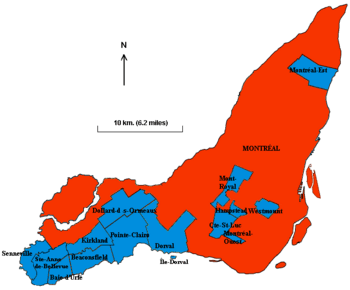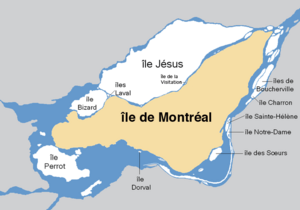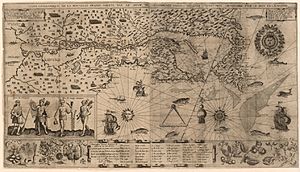Island of Montreal facts for kids

Map of the Island of Montreal
|
|
| Geography | |
|---|---|
| Location | Saint Lawrence River |
| Coordinates | 45°30′01″N 73°38′47″W / 45.50028°N 73.64639°W |
| Archipelago | Hochelaga Archipelago |
| Area | 499.19 km2 (192.74 sq mi) |
| Length | 50 km (31 mi) |
| Width | 16 km (9.9 mi) |
| Highest elevation | 233 m (764 ft) |
| Highest point | Mount Royal |
| Administration | |
|
Canada
|
|
| Province | Quebec |
| City | Montréal |
| Demographics | |
| Population | 1,942,044 (2016) |
| Pop. density | 3,890 /km2 (10,080 /sq mi) |
| Ethnic groups | multiracial (200 ethnic groups) |
The Island of Montreal (called Île de Montréal in French) is a large island in southwestern Quebec, Canada. It's where the big city of Montreal is located. The island sits where the Saint Lawrence River and the Ottawa River meet. Another river, the Rivière des Prairies, separates it from Île Jésus (where the city of Laval is).
Contents
Island of Montreal: Physical Features

The Island of Montreal is about 50 kilometers (30 miles) long. At its widest point, it is about 16 kilometers (10 miles) across. The shoreline stretches for 266 kilometers (165 miles).
It is the second largest island in the Saint Lawrence River. Only Anticosti Island, located further east, is bigger. The Island of Montreal is the biggest island in the Hochelaga Archipelago. This group of islands formed where the Ottawa and Saint Lawrence rivers come together.
The Saint Lawrence River gets wider into Lake Saint-Louis southwest of the island. It then narrows into the Lachine Rapids. After that, it widens again into the Bassin de La Prairie. Finally, it narrows and flows towards Quebec City and the Atlantic Ocean.
There are other islands near Montreal. Saint Helen's Island and Notre Dame Island are in the Saint Lawrence River, southeast of downtown Montreal. Nuns' Island is southwest of downtown. The Lachine Canal also cuts through the southwest part of the island.
At the center of the island, you'll find Mount Royal. This is a small mountain, about 233 meters (765 feet) high. It's part of a group of hills called the Monteregian Hills. Mount Royal is not an extinct volcano, but it was formed by a type of rock called a volcanic intrusion.
Island of Montreal: People and Places
The Island of Montreal is the main part of the city of Montreal. It also includes smaller islands like Île Bizard, Saint Helen's Island, Notre Dame Island, and Nuns' Island. With over 2 million people, it is the most populated island in Canada.
It is also one of the most populated islands in the Americas. In fact, it has more people than Manhattan Island in New York City. The Island of Montreal is also the most populated island in the world that is surrounded by fresh water.
The city of Montreal and other towns on the island form the administrative region of Montréal. This area covers about 499 square kilometers (193 square miles).
Many bridges connect the island to the surrounding areas. These bridges are some of the busiest in the country. For example, the Champlain Bridge and the Jacques Cartier Bridge are used by over 100 million vehicles each year.
Island of Montreal: How it Got its Name

The first French name for the island was l'ille de Vilmenon. Samuel de Champlain noted this name on a map in 1616. It was named after a person called sieur de Vilmenon.
However, by 1632, Champlain used the name Isle de Mont-real on another map. The island got its name from Mount Royal. The name then spread to the town, which was first called Ville-Marie.
In the Kanien’kéha, the island is called Tiohtià:ke Tsi. This name refers to the Lachine Rapids southwest of the island. Another name is Ka-wé-no-te. In the Anishninaabemowin, the land is called Mooniyaang. This name comes from the French word for the city.
Municipalities on the Island of Montreal
- Baie-d'Urfé
- Beaconsfield
- Côte-Saint-Luc
- Dollard-des-Ormeaux
- Dorval
- L'Île-Dorval
- Hampstead
- Kirkland
- Montreal
- Montréal-Est
- Montréal-Ouest
- Mount Royal
- Pointe-Claire
- Sainte-Anne-de-Bellevue
- Senneville
- Westmount
Island of Montreal: Population Facts
The Island of Montreal has grown a lot over the years. Here's how its population has changed:
| 1876 | 1890 | 1931 | 1941 | 1951 | 1961 | 1971 | 1981 | 1991 | 1996 | 2001 | 2006 | 2011 |
|---|---|---|---|---|---|---|---|---|---|---|---|---|
| est. 120,000 | est. 200,000 | 1,003,868 | 1,116,800 | 1,320,232 | 1,747,696 | 1,959,180 | 1,760,122 | 1,775,871 | 1,775,846 | 1,812,723 | 1,854,442 | 1,886,481 |
The map shows the main languages spoken in different towns on the island. Blue areas are mostly French-speaking. Pink areas are mostly English-speaking.
See also
 In Spanish: Isla de Montreal para niños
In Spanish: Isla de Montreal para niños



